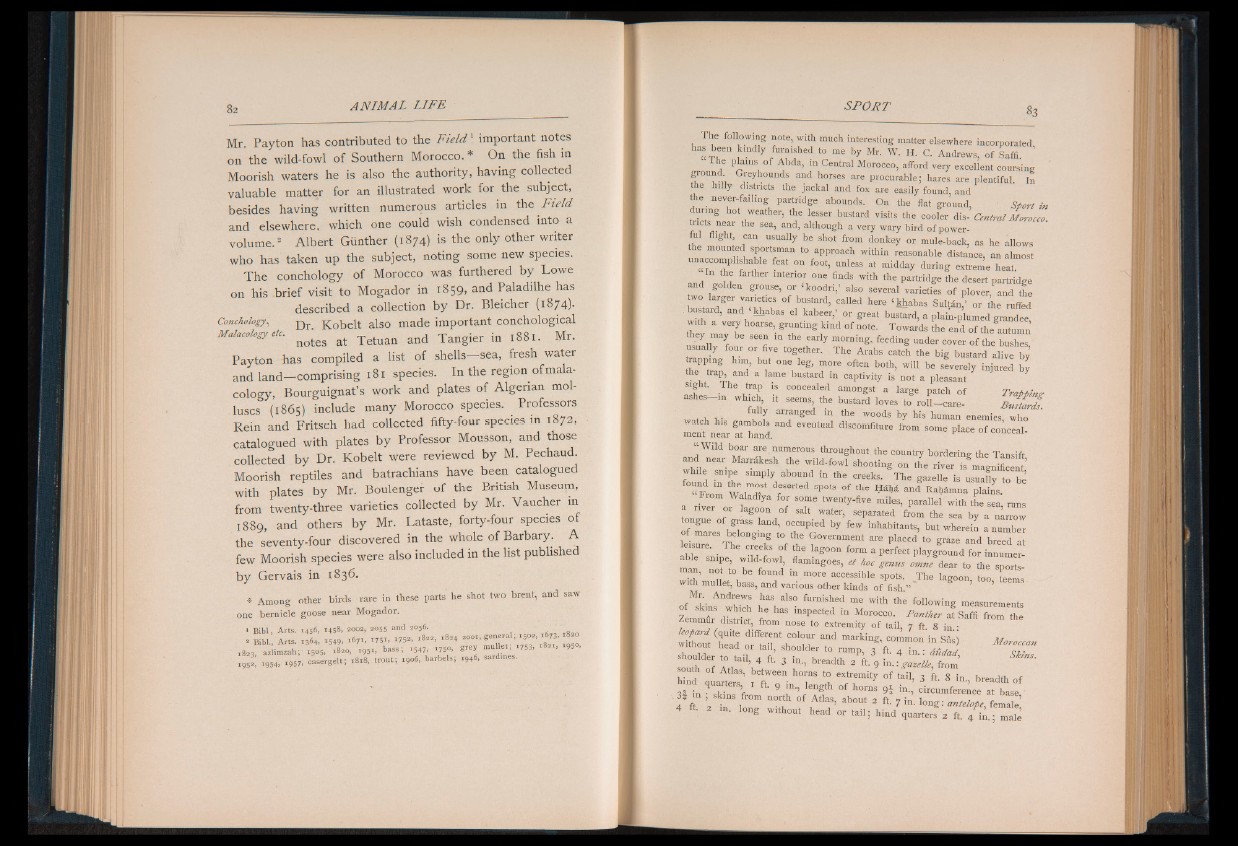
82 ANIM AL L IF E
Mr. Payton has contributed to the F ie ld 1 important notes
on the wild-fowl of Southern Morocco. * On the fish in
Moorish waters he is also the authority, having collected
valuable matter for an illustrated work for the subject,
besides having written numerous articles in the F ield
and elsewhere, which one could wish condensed into a
volume.3 Albert Günther (1874) is the only other writer
who has taken up the subject, noting some new species.
The conchology of Morocco was furthered by Lowe
on his brief visit to Mogador in 1859, and Paladilhe has
described a collection by Dr. Bleicher (1874).
Conchology, Kobelt also made important conchological
Malacology etc. ^ ^ ^ J H in l 8 8 l . M r .
Payton has compiled a list of sh e lls-sea , fresh water
a n d l a n d — comprising 181 species. In the region of malacology,
Bourguignat’s work and plates of Algerian molluscs
(1865) include many Morocco species. Professors
Rein and Fritsch had collected fifty-four species in 1872,
catalogued with plates by Professor Mousson, and those
collected by Dr. Kobelt were reviewed by M. Pechaud.
Moorish reptiles and batrachians have been catalogued
with plates by Mr. Boulenger of the British Museum,
from twenty-three varieties collected by Mr. Vaucher in
1889, and others by Mr. Lataste, forty-four species o f
the seventy-four discovered in the whole of Barbary. A
few Moorish species were also included in the list published
by Gervais in 1836.
* Among other birds rare in these parts he shot two brent, and saw
one bernicle goose near Mogador.
* B ib l, Arts. 1456, 1458, 2002, 2055 and 2056. ' '
■ Bibl., Arts. X364, XS49, x7Sx, x752, x8s2, x824 | |
1823, azlimzah;- 1505, 1820, 195X, bass; 1547, 'S3 grey mullet, 753,
1952, 1954, 1957, casergelt; 18x8, trout; 1906, barbels; 1946, sardines.
SPO R T 83
he following note, with much interesting matter elsewhere incorporated
ft-iu6“ , y furmshed t0 me by Mr- W. H. C. Andrews, of Saffi
The plains of Abda, in Central Morocco, afford very excellent coursing
ground Greyhounds and horses are procurable; hares are plentiful. In
the hilly districts the jackal and fox are easily found, and
the never-failing partridge abounds. On the flat ground, ■ Short in
tricte L tbWeather’ !eSSer bUStard Visils the cooler dis'tricts neai the sea, and, although a very wary bird of power
Central Morocco.
ful flight can usually be shot from donkey or mule-back, as he allows
the mounted sportsman to approach within reasonable distance, an almost
unaccomplishable feat on foot, unless at midday during extreme heat.
and ¡Si H I °ne Bi Wkh the B1S1th e desert P a r tr id g e and golden grouse, or ‘ koodri,’ also several varieties of plover, and the
two larger varieties of bustard, called here ‘ khabas Sultán/ or the ruffed
bustard, and Miabas el kabeer,’ or great bustard, a plain-plumed grandee
with a very hoarse, grunting kind of note. Towards the end of the autumn
they may be seen in the early morning, feeding under cover of the bushes
usually four or five together. The Arabs catch the big bustard alive by
trapping him, but one leg, more often both, will be severely injured by
, and a lame bustard in captivity is not a pleasant
N T . 13 CODCealed amongst a large patch of Trahtimr
' wnteb v b f ar? “ g m ^ W° ° ds b? his hum“ enemies, who « i r í e"““1 di,comfi,u'' r a » o f c « « a .
“ Wild boar are numerous throughout the country bordering the Tansift
and near Marrakesh the wild-fowl shooting on tie river is magnificent
while snipe simply abound in the creeks. The gazelle is u s n Z to be
found m the most deserted spots of the Háhá and Rahámna plains.
From Waladiya for some twenty-five miles, parallel with the sea, runs
t o n ^ r r g01° n , ° f 3alt water> separated from the sea by a narrow
tongue of grass land, occupied by few inhabitants, but wherein a number
of mares belong.ng.to the Government are placed to graze and breed*
leisure. _ The creeks of the lagoon form a perfect p la y J L n d for innumeÍ
mmaann , nnoott ttoo bbee ffo undí mfl ammÍonreg °aeSc’c e1ssi5ble spots. The lda^goo tno, ttohoe stpeoermtsswith
mullet, bass, and various other kinds of fish.” '
Mr. Andrews has also furnished me with the following measurements
of skms which he has inspected in Morocco. Panther a! Saffi from ^ the
Zemmur district, from nose to extremity of tail, 7 ft. 8 in
leofard (quite different colour and marking,common in Sfist M
...b cu , I B « , „ „ a , „ f F ' lL I T
,t,w ?„“V "■31 “ 2" ’ “• outh of Atlas, between horns to extremity of tail, 3 ft. 8 in breadth of
hmd quarters t ft. 9 in„ length of horns 9 i in,’
4 ft 2In “ 3 1 ■ ° f AtkS’ ab°Ut 2 f t 7 L n g : antelope, female 4 . in. long without head or tail; hind quarters 2 ft. 4 in. - male